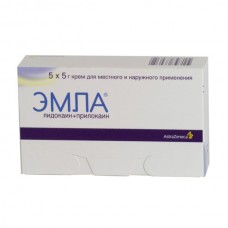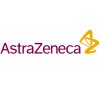Expiration date: 08/2026
The composition and form of issue:
Cream for local and external use. 1 g contains:
active substances:
lidocaine 25 mg
prilocain 25 mg
excipients: macrogol glycerylmonostearate (ARLATONE 289) Carbomer 974 P (carboxypolymethylene) sodium hydroxide to bring the pH to 8, 7-9, 7 purified water
in the box of aluminum of 5 g in a cardboard bundle 5 PCs or aluminum tubes of 30 gr in carton box 1 PCs.
The therapeutic system. 1 g of emulsion contains:
active substances:
lidocaine 25 mg
prilocain 25 mg
excipients: macrogol glycerylmonostearate (Arlatone 289) carboxypolymethylene sodium hydroxide to bring the pH to 8, 5-9, 7 purified water to 1 g
in the package contour bezyazykov 1 system consisting of a protective laminate (plastic/aluminum/plastic laminate) and separating pads (laminated paper). Protective laminate is hermetically connected to a flexible substrate using an annular zone around the cellulose disk. In the paper cartons with tamper-evident 2 or 20 contour bezyazykov packages.
Description pharmaceutical form:
Cream: uniform, white.
The therapeutic system consists of adhesive medicinal parts and flexible substrates. Adhesive medicinal part consists of a round cellulose disc diameter 3, 5 cm, attached to a flexible substrate. Pulp disc white or whitish impregnated with 1 g of 5% EMLA emulsion.
The circumference of the pulp of the disc are adhesive tape, square shape with rounded edges. The flexible substrate is a round shape with lugs — plastic/aluminum/plastic laminate.
Indications:
For both dosage forms
surface anaesthesia of the skin with injections, punctures and catheterization of blood vessels and superficial surgical procedures
For the cream additionally
surface anesthesia of trophic ulcers of the lower limbs during surgical treatment (mechanical cleaning), for example removal of fibrin, pus, and necrotic tissue
surface anaesthesia of the mucous membrane of the genital organs prior to conducting painful procedures (only in adults) and for anesthesia before the injection of local anesthetics.
Contraindications:
For both dosage forms
hypersensitivity to local anesthetics of the amide type or to any component of the drug
premature neonates born with gestational age less than 37 weeks.
For the cream additionally
newborns weighing less than 3 kg.
With caution
Cream: deficiency of glucose-6-phosphate dehydrogenase, hereditary or idiopathic methemoglobinemia, generalized neurodermatitis (atopic dermatitis), patients receiving antiarrhythmic drugs class III (e.g., amiodarone) (see "Special instructions").
Therapeutic system: in applying the drug near the eye before subcutaneous injection of a live vaccine (e.g. BCG) in the case of application to the skin in widespread atopic dermatitis (atopic dermatitis) does not recommend the combined use of the drug EMLA and drugs that cause methemoglobinemia in children aged 0 to 12 months in patients with deficiency of glucose-6-phosphate dehydrogenase is not recommended to use this product on open wounds.
Application of pregnancy and breast-feeding:
Pregnancy
Insufficient data on the use of EMLA cream in pregnant women. In studies conducted on animals revealed no direct or indirect negative impact of the drug on pregnancy, fetal development, birth or postnatal development. Lidocaine and prilocaine cross the placental barrier and can be absorbed in the tissues of the fetus. Not been reported on any of the specific disorders of the reproductive process, such as an increase in the frequency of malformations or other direct or indirect negative effects on the fetus. Should take into account the fact that lidocaine and prilocaine was used in a large number of pregnant women and women of childbearing age. However, caution must be exercised when using the drug in pregnant women.
Lactation
Lidocaine and prilocaine are excreted in breast milk in amounts that do not pose a risk to the child when using the drug in therapeutic doses.
Side effects:
Frequent (>1/100)
The skin: transient local reactions in the area of application of the drug, such as paleness, redness and swelling.
Less common (<1/100, >1/1000)
From the skin: for the first time after application — a slight burning and itching of the skin (in the area of application of the drug).
Rare (<1/1000)
General: allergic reactions, in the most severe cases, anaphylactic shock methemoglobinemia in children.
There are few reports on cases of local reactions in the area of application of the drug, such as hemorrhagic rash or petechiae, especially after long-term application in children with atopic dermatitis or warts. Irritation of the cornea due to accidental contact with the cream or cover the patch in the eye.
Method of application and dose:
Cream.
Externally, on the skin or mucosa.
Adults
Surface anesthesia of intact skin
| Indications | Dosage and method of application | Application time |
| With the introduction of the needle, for example, in catheterization of blood vessels and when taking blood samples | half a 5 g tube (approximately 2 g) for 10 cm2 to apply a thick layer on the skin and cover with occlusive dressing | 1 hour, maximum 5 hours |
| For small surgical procedures, such as when the curettage of molluscum contagiosum and warts | 1, 5-2 g/10 cm2, apply a thick layer on the skin and cover with occlusive dressing | 1 hour, maximum 5 hours |
| For superficial treatments over large areas, for example, the taking of skin using split flap | 1, 5 -2 g/10 cm2, apply a thick layer on the skin and cover with occlusive dressing | 2 hours, maximum 5 hours |
Surface anesthesia of trophic ulcers of the lower extremities
During surgical treatment (mechanical cleaning) of trophic ulcers of the lower extremities, a single dose of about 1-2 g/10 cm2 apply a thick layer of cream on the ulcer surface, not more than 10 g of cream for the procedure. To put an occlusive dressing. Application time: at least 30 min.
Opened the tube of cream is for single use, the tube with the remnants of the cream should be discarded after use in one patient.
In the case of treatment of ulcers, in tissues where drug penetration is hindered, the duration of an application can be increased to 60 min. Mechanical cleaning must start no later than 10 min after removal of the cream.
When manipulation ulcers of the lower limbs EMLA cream was used up to 15 times within 1-2 months without loss of efficiency and increase in the incidence of local reactions.
Surface anaesthesia of the genital organs
Genital skin:
Anesthesia before injections of local anaesthetics
Men: 1 g/10 cm2. Apply a thick layer of cream on the skin. Application time — 15 min.
Women: 1– 2 g/10 cm2. Apply a thick layer of cream on the skin. Time of application — 60 min.
Surface anaesthesia of the mucous membrane of the genital organs
When removing warts and analgesia before injection of local anesthetics: about 5-10 grams, depending on the size of the treated surface. The cream should be applied to the entire mucosal surface, including the folds of the mucous membrane. An occlusive bandage is not required. Application time is 5-10 min. to Carry out the procedure immediately after removal of cream.
Children
Anesthesia as the needle, when the curettage of molluscum contagiosum and other minor superficial surgical procedures
Apply a thick layer of cream on the skin and cover occluzionna bandage. The dose should correspond to the machined surfaces and should not exceed 1 g of cream per 10 cm2 .
| Age | Area of application | The duration of an application |
| 0–3 month | maximum 10 cm2 (total of 1 g cream maximum daily dose) | 1 hour (important: no more than 1 hour) |
| 3–12 month | maximum 20 cm2 (total 2 g cream) | 1 hour |
| 1–6 years | maximum 100 cm2 (total of 10 g of the cream) | 1 hour, maximum 5 hours |
| 6–12 years | maximum 200 cm2 (total 20 g cream) | 1 hour, maximum 5 hours |
Increasing the time of an application reduces the anesthesia. In children with widespread atopic dermatitis (atopic dermatitis) application time should be reduced to 30 min.
Apply a thick layer of cream on the skin and cover occluzionna bandage.
Overdose:
Symptoms: when following the recommended dosing regimen of the drug are unlikely to develop signs of systemic toxicity. The symptoms of intoxication, probably the same as with other local anesthetics, such as Central nervous system excitation and in severe cases, CNS depression and cardiac activity.
In rare cases, the children noted the development of clinically relevant methemohlobinemia. Prilocaine in high doses can cause a rise in the level of methemoglobin.
Surface application of 125 mg of prilocaine duration of 5 h led to the development of moderate methemohlobinemia in 3-month-old baby. Surface application of lidocaine in a dose of 8, 6-17, 2 mg/kg caused serious toxicity in newborns.
Treatment: severe neurological symptoms (convulsions, CNS depression) require symptomatic treatment, including the appointment of anticonvulsants and, if necessary IVL. In the case of the development of methemohlobinemia an antidote is methylthionine chloride (methylene blue).
Due to slow systemic absorption of the drug should observe patients for several hours after the start of treatment of intoxication
Special instructions:
Common to all dosage forms.
Patients with deficiency of glucose-6-phosphate dehydrogenase or hereditary or idiopathic methemoglobinemia are more susceptible to lekarstvennymi of methemohlobinemia.
Not established the efficacy of the cream in newborns during the process of taking blood samples from the heel.
Care should be taken when applying EMLA drug around the eyes, because the drug causes eye irritation. Loss of protective reflexes may allow the irritation and corneal damage. When hit the cream in your eyes, immediately rinse eyes with water or saline solution or eye protection until recovery of protective reflexes.
Care must be taken when applying the product to the skin with widespread atopic dermatitis (atopic dermatitis) application time should be reduced (15-30 min).
In children under the age of 3 months the safety and efficacy of EMLA cream was determined after applying a single dose. Such children after applying the cream often observed a temporary increase in levels of methemoglobin in the blood up to 13 h. However, the observed increased levels of methemoglobin in the blood, probably, has no clinical significance.
Do not apply the medication in open wounds.
Lidocaine and prilocaine at a concentration above 0, 5-2% have antibacterial and antiviral properties. In this regard, it is recommended to pay special attention when applying the cream prior to subcutaneous injection of a live vaccine (e.g. BCG).
Effects on ability to drive and operate machinery. Was not observed decrease of the reaction when using the drug EMLA.
For the cream additionally
Patients taking antiarrhythmic drugs class III (e.g. amiodarone) should be under the supervision and ECG monitoring, because the effects on cardiac function.
Do not apply EMLA cream to the damaged eardrum or in other cases some penetration of the cream into the middle ear.
Due to lack of data on absorption of the drug is not recommended to apply the cream on the mucous membrane of the genital organs in children.
For the vehicle additionally
Lack of data does not recommend the combined use of the drug EMLA and drugs that cause methemoglobinemia in children ages 0 to 12 months.



